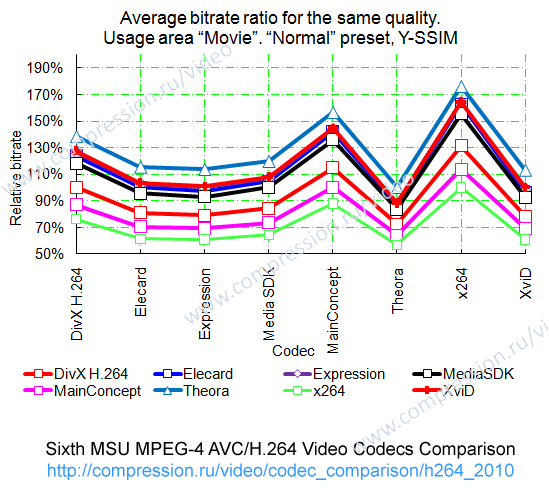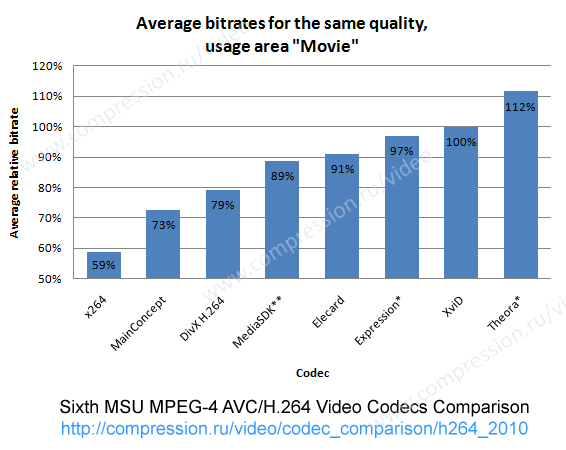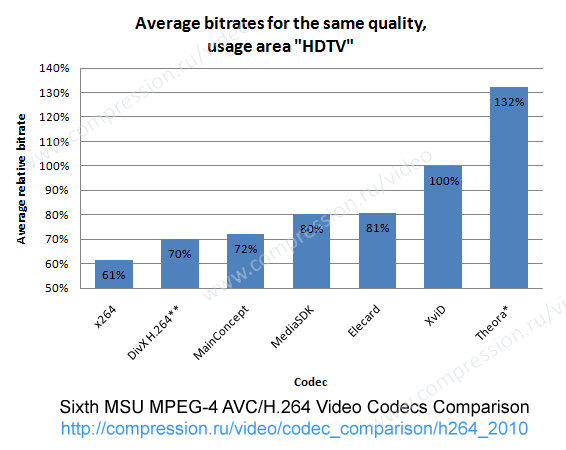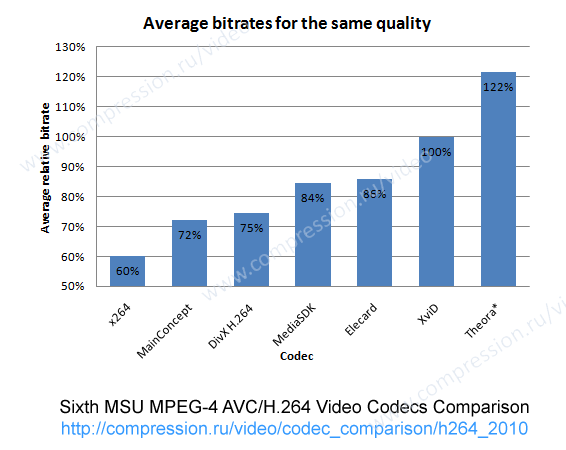Sixth MPEG-4 AVC/H.264 Video Codecs Comparison - Short Version
MSU Graphics & Media Lab (Video Group)
History of versions
Different Versions of Report
There are four different versions of H.264 Comparison 2010 report: Here is the comparison of the versions:| Short Version | Pro Version (Movies) | Pro Version (HDTV) | Pro Version (Enterprise) | |
|---|---|---|---|---|
| Objective Metrics (SSIM) | ||||
| Additional Metrics (PSNR) | For all results SSIM and PSNR metrics are used | For all results SSIM and PSNR metrics are used | For all results SSIM and PSNR metrics are used | |
| Movie use case | Only Normal preset | High Speed, Normal, High Quality presets | High Speed, Normal, High Quality presets | |
| HDTV use case | High Speed, Normal, High Quality presets | High Speed, Normal, High Quality presets | ||
| Subjective Comparison | SAMVIQ analysis including psycho-visual enhancements | |||
| Additional Analysis | Synthetic Motion Analyzer | |||
| Additional Analysis | Distortion in Tail Area Analyzer | |||
| Additional Analysis | Spatially Variable Noise Analyzer | |||
| Number of pages | 25 | 116 | 114 | 177 |
| Number of figures | 50 | 131 | 131 | 226 |
| Prices | Free | $349 | $349 | $699 |
| Purchase |  |
 |
 |
 |
| Hint: You can remove "Extended download" service while purchasing to save money. | ||||
| We can help you to analyze your codec | ||||
Pro versions of report will be available immediately after report purchasing.
Html-Version of Report
Video Codecs that Were Tested
Overview
Sequences
| Sequence | Number of frames | Frame rate | Resolution |
|---|---|---|---|
| Ice Age | 2014 | 24 | 720x480 |
| Indiana Jones | 5000 | 30 | 704x288 |
| State Enemy | 6500 | 24 | 720x304 |
| Up | 1920 | 24 | 720x480 |
| Amazon | 1200 | 24 | 1280x720 |
| Iron Man | 600 | 24 | 1920x1080 |
| Mobile Calendar | 504 | 50 | 1280x720 |
| Troy | 300 | 24 | 1920x1072 |
Codecs
| Codec | Developer | Version |
|---|---|---|
| DivX AVC/H.264 Video Encoder | DivX, Inc. | version 1.1.1.6 |
| Elecard AVC Video Encoder 8-bit edition | Elecard Ltd | 2.1.022202.091207 |
| Intel® MediaSDK AVC/H.264 transcoder sample application | Intel Corp. | 1.10.1.15 |
| MainConcept AVC/H.264 Video Encoder Console Application | MainConcept GmbH | 8.5.0.12837 |
| Microsoft Expression Encoder 3 | Microsoft Corp. | 3.0.1332.0 |
| Theora encoder | Xiph.Org. | Provided by developers |
| x264 | x264 Development Team | x264 core:85 r1442M 781d300 |
| XviD raw mpeg4 bitstream encoder | XviD Development Team | xvid-1.3.0-dev |
to test and analyze its codec.
Objectives and Testing Rules
H.264 Codec Testing Objectives
The main goal of this report is the presentation of a comparative evaluation of the quality of new H.264 codecs using objective measures of assessment. The comparison was done using settings provided by the developers of each codec.
The main task of the comparison is to analyze different H.264 encoders for the task of transcoding video—e.g., compressing video for personal use. Speed requirements are given for a sufficiently fast PC; fast presets are analogous to real-time encoding for a typical home-use PC.
Testing Rules
Results for Movies
H.264 Comparison Report Pro 2010 - Movie edition
H.264 Comparison Report Pro 2010 - Enterprise edition
RD Curves
The Normal preset results for each sequence are presented in next figures. The results do not depend strongly on the metric used. SSIM metric: The leader is x264; MainConcept placed second, and DivX H.264 placed third. For the "Ice Age" and "Up" sequences, the MediaSDK and Elecard encoders exhibited similar results. For the "Indiana Jones" and "State Enemy" sequences, the XviD encoder placed fourth.
Encoding Speed
Absolute speed results are presented in next figures. All the encoders except Microsoft Expression and Theora have a similar growth rate for encoding time versus increasing bitrate. Elecard is the fastest encoder. The encoding speed of the Microsoft Expression and Theora encoders exhibits almost no dependency on bitrate, and Microsoft Expression’s encoding speed decreases at 1,200 kbps for the “Ice Age” sequence. XviD’s encoding speed exhibits little dependency on bitrate for the “Up” sequence.Speed/Quality tradeoff
The speed/quality trade-off graphs simultaneously show relative quality and encoding speed for the encoders tested in this comparison. XviD is the reference codec, for which both quality and speed are normalized to unity for all of the graphs. The terms “better” and “worse” are used to compare codecs in the same manner as in previous portions of this comparison.
Next figures show results for the Normal preset. The results differ depending on the chosen metric.
Y-SSIM: The three best codecs (no codec performs faster with higher quality) in terms of speed and quality are XviD, Elecard and x264 on average, except for the "Ice Age" and "Indiana Jones" sequences. The x264 encoder is better on average than DivX H.264 and MainConcept.
Almost all encoders except Microsoft Expression exhibited better results on average than did Theora.
Bitrate Handling
Encoders with Normal presets, except the Microsoft Expression encoder, demonstrate good bitrate handling for all sequences. For the “Up” sequence, XviD showed less than stellar results, especially at high bitrates. For all sequences, MainConcept, x264, Elecard and DivX H.264 showed the best results compared with other encoders. DivX H.264’s bitrate decreases at 1,500 kbps. MediaSDK slightly decreases bitrates, but the results are stable. Theora has a good bitrate handling mechanism but is not very stable.Relative Quality Analysis
Next table shows relative bitrates for a fixed-quality output for all codecs. Note that these tables do not include information about the speed of the encoder.
The leaders are x264 and MainConcept, depending on the quality metric (the bitrate difference is 18% for a fixed quality).
| DivX H.264 | Elecard | Expression | MediaSDK | MainConcept | Theora | x264 | XviD | |
|---|---|---|---|---|---|---|---|---|
| DivX H.264 | 100% | 124% | 127% | 118% | 87% | 138% | 76% | 128% |
| Elecard | 81% | 100% | 103% | 95% | 70% | 115% | 61% | 104% |
| Expression | 79% | 97% | 100% | 93% | 69% | 114% | 61% | 101% |
| Media SDK | 84% | 105% | 107% | 100% | 74% | 120% | 64% | 108% |
| MainConcept | 115% | 142% | 144% | 136% | 100% | 157% | 88% | 145% |
| Theora | 72% | 87% | 88% | 84% | 64% | 100% | 57% | 88% |
| x264 | 131% | 163% | 164% | 155% | 114% | 176% | 100% | 164% |
| XviD | 78% | 96% | 99% | 93% | 69% | 113% | 61% | 100% |

Results for HDTV
H.264 Comparison Report Pro 2010 - HDTV edition
H.264 Comparison Report Pro 2010 - Enterprise edition
Speed/Quality tradeoff
The speed/quality trade-off graphs simultaneously show relative quality and encoding speed for the encoders tested in this comparison. XviD is the reference codec, for which both quality and speed are normalized to unity for all of the graphs. The terms “better” and “worse” are used to compare codecs in the same manner as in previous portions of this comparison.
Conclusions
Movies
The leading encoders in this usage area are MainConcept and x264. The quality of the Theora encoder is rather low.High Speed Preset
The x264 encoder demonstrates better quality on average, and MainConcept shows slightly lower quality. These codecs’ bitrate handling algorithm is acceptable for this usage area. The MediaSDK codec places third, along with the dicas encoder (MediaSDK has slightly higher quality, but its encoding speed is 25% lower). The top four codecs for this preset are the following:- x264
- MainConcept
- MediaSDK
Normal Preset
The results for the Normal preset differ from those for the High Speed presets only in third place. The x264 encoder demonstrates better quality on average, and MainConcept shows slightly lower quality. The DivX H.264 encoder holds third place. The top three codecs for this preset are the following:- x264
- MainConcept
- DivX H.264
High Quality Preset
The results for this preset are similar to those of the Normal preset. The leaders are the x264 and MainConcept codecs. DivX H.264 takes third place. The top three codecs for this preset are the following:- x264
- MainConcept
- DivX H.264

**The MediaSDK encoder does not meet the requirements for High Speed presets–specifically, no B-frames and exactly one reference frame
HDTV
The leaders in the HDTV area are x264, DivX H.264 and MainConcept. The XviD encoder trails all other H.264 encoders. Theora demonstrates rather poor results compared with other encoders.High Speed Preset
The x264 encoder demonstrates better quality on average, and MainConcept shows slightly lower quality. The top three codecs for this preset are the following:- x264
- DivX H.264 (this preset does not meet speed requirements)
- MainConcept
Normal Preset
The results for the Normal preset differ from those of the High Speed presets. MainConcept shows the best results. The difference between best codecs are 2-4% of bitrate for the same quality. The top three codecs for this preset are the following:- MainConcept
- x264
- DivX H.264
High Quality Preset
The results for the High Quality preset are very interesting: x264 held first place, MainConcept was in second place, and two codecs (DivX H.264 and Elecard) shared third place (their quality results are very close, but DivX H.264 is 1.2 times faster than Elecard). The top four codecs for this preset are the following- x264
- MainConcept
- DivX H.264 and Elecard

**The DivX H.264 High Speed preset for HDTV does not meet the speed requirements
Overall Conclusions
Overall, the leader in this comparison is x264, followed by MainConcept and DivX H.264. The Theora encoder demonstrates the worst results among all codecs tested.
The overall ranking of the codecs tested in this comparison is as follows:
- x264
- MainConcept
- DivX H.264
- MediaSDK
- Elecard
- XviD
- Theora
Microsoft Expression Encoder 3 could not be placed in this list because of its much longer encoding time compared with other encoders (except Theora).
Using the standard Theora interface, we could not find any multithreading options; Theora works only in single-thread mode. The leader in this comparison is x264—its quality difference (according to the SSIM metric) could be explained by the special encoding option ("--tune ssim"). Interestingly, using the PSNR metric for MainConcept yielded results comparable with or better than those of x264. This means that no encoder can achieve the best results for both SSIM and PSNR when using the same parameters.
The difference between the MainConcept and DivX H.264 encoders is not overly significant, so these encoders tied for second in this comparison. The developers of the Elecard encoder do not provide a High Speed preset, so its ranking is based solely on the results for the Normal and High Quality presets. The dicas encoder holds third or fourth place for some sequences.
This rank is based only on the encoders’ quality results. Encoding speed is not considered here.
Codec Conclusion
Professional Versions of Comparison Report
H.264 Comparison Report Pro 2010 versions contain:
Acknowledgments
Thanks

|

|

|

|

|

|

|

|

|

|

|

|

|

|

|
Appendixes
Codec Analysis and Tuning for Codec Developers and Codec Users
Computer Graphics and Multimedia Laboratory of Moscow State University:
Strong and Weak Points of Your Codec
Independent Codec Estimation Comparing to Other Codecs for Different Use-cases
Encoder Features Implementation Optimality Analysis
We perform encoder features effectiveness (speed/quality trade-off) analysis that could lead up to 30% increase in the speed/quality characteristics of your codec. We can help you to tune your codec and find best encoding parameters.Contact Information
 |
MSU video codecs comparisons resources:
- Introduction to Video Codecs Comparison
- Lossless Video Codecs Comparison 2004 (October 2004)
- MPEG-4 SP/ASP Video Codecs Comparison (March 2005)
- JPEG 2000 Image Codecs Comparison (September 2005)
- First Annual MPEG-4 AVC/ H.264 Video Codecs Comparison (January 2005)
- Second Annual MPEG-4 AVC/H.264 Video Codec Comparison (December 2005)
- Subjective Comparison of Modern Video Codecs (February 2006)
- MPEG-2 Video Decoders Comparison (May 2006)
- WMP and JPEG2000 Comparison (October 2006)
- Third Annual MPEG-4 AVC/H.264 Comparison (December 2006) (All versions for free!)
- Lossless Video Codecs Comparison 2007 (March 2007)
- Fourth Annual MPEG-4 AVC/H.264 Comparison (December 2007) (All versions for free!)
- Options Analysis of MPEG-4 AVC/H.264 Codec x264 (December 2008)
- Fifth MPEG-4 AVC/H.264 Comparison (May 2009) (All versions for free!)
- Sixth MPEG-4 AVC/H.264 Comparison (May 2010)
- Seventh MPEG-4 AVC/H.264 Comparison (May 2011)
- Eighth MPEG-4 AVC/H.264 Comparison (May 2012)
- Ninth MPEG-4 AVC/H.264 Comparison (Dec 2013)
Other Materials
Video resources:
Server size: 8069 files, 1215Mb (Server statistics)
Project updated by
Server Team and
MSU Video Group
Project sponsored by YUVsoft Corp.
Project supported by MSU Graphics & Media Lab